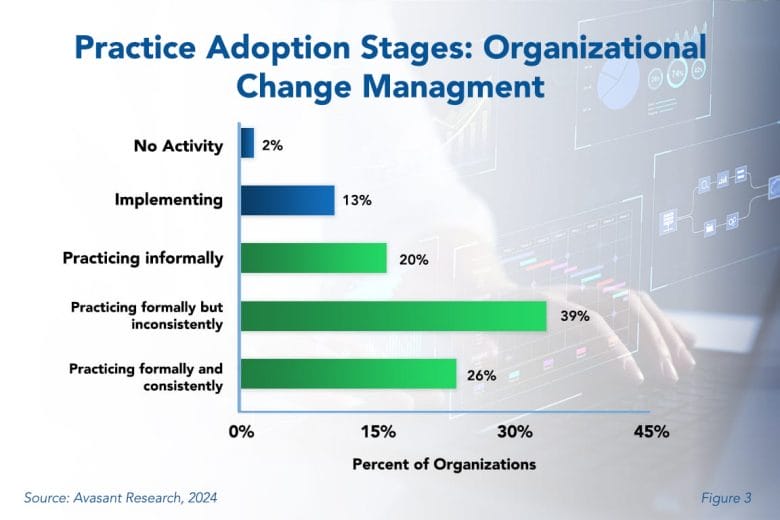The pace of change in many companies is increasing as new technologies allow businesses to serve customers faster, better, and cost-effectively. In most industries, therefore, new systems are essential to compete in today’s global economy. However, it is not always as simple as buying a new system and expecting users to adopt it seamlessly. Many new projects fail without the effective use of change management. And some companies still fall behind in formal and consistent practice of change management best practices.
While most know about and practice some form of organizational change management, Figure 3 from our full report, Organizational Change Management Best Practices, shows that only a small percentage, 26%, practice it formally and consistently. So, what is preventing the other companies from engaging in formal and consistent practice?

“IT leaders often focus on the purely technical side of a new system,” said Waynelle John, research analyst for Avasant Research, based in Los Angeles. “But it is important, as digital transformation increases, to make sure you pay attention to the people side.”
Organizational change management practices can help companies leverage new systems more effectively. IT leaders are not as resistant to change as they once were, but inadequate training and support, unrealistic expectations, or a lack of governance and strategic leadership might hinder them. The good news is that several disciplines have evolved over many years to maximize user adoption through a comprehensive approach. There are formal methodologies that business and IT leaders can apply to establish and carry out an organizational change management program.
When it comes to IT, organizational change management is especially needed for projects where the full return on investment depends highly on user acceptance of the change. However, it becomes imperative for critical systems, such as a new CRM system. The implementation of ERP systems and other enterprise-wide business applications also requires a formal change management program.
Nevertheless, it is important to remember that this practice is not limited to IT. These disciplines can and should be used to ensure maximum adoption of any change. It includes activities to ensure that all affected workers understand the need for the change, get behind it, and get trained to work in the future state. It also includes actions to overcome resistance where it exists. Everyone involved in the change has a role to play.
In our full report, we look at adoption trends and maturity of organizational change management by organization size and sector. We conclude with practical recommendations for companies to start or improve their change management practices.
This Research Byte is based on our report Organizational Change Management Best Practices. The full report is available at no charge for subscribers, or it may be purchased by non-clients directly from our website (click for pricing).

